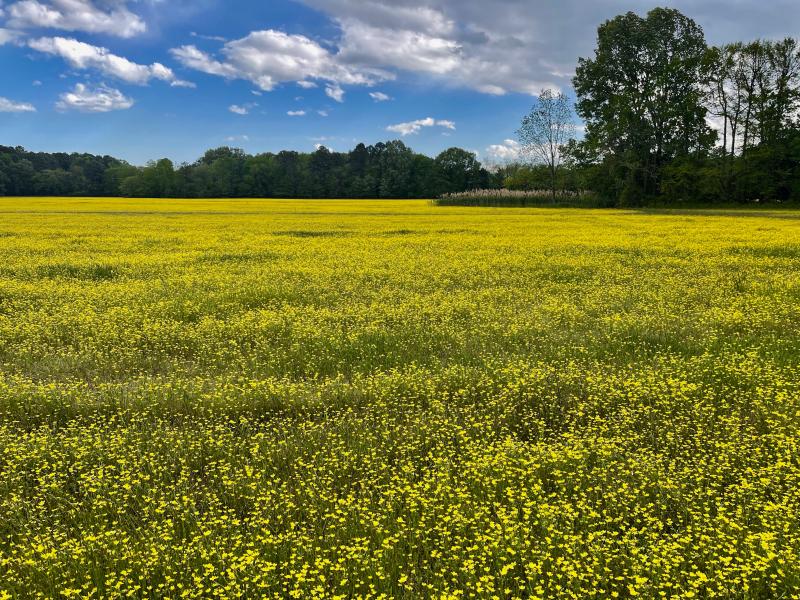Cruciferous flowers now brightening Delmarva fields
A broad, gently rolling field of brilliantly yellow flowers along the road between Easton and St. Michaels caught my eye - and that of thousands more passing motorists - in recent days.
May on Delmarva. A cover crop that soon - if not already - will likely be plowed under or killed off to make way for corn or soybeans, the two major crops of the peninsula.
My first thought when looking at the field was canola.
Many are familiar with the vegetable cooking oil known as canola but they may not know that canola is a word created by rapeseed growers in Canada many years ago in their search for a kinder word to denote their crop.
Reminiscent of the familiar phrasing of New York Times Puzzle Editor Will Shorts on his Sunday morning NPR segment,, take part of the name of a North American nation, put it together with the fabricated name of a slick liquid used in everything from cooking and salad dressing to biodiesel and metal machinery lubricants, and find a six-letter word now in common culinary usage. Winner, winner, chicken dinner!
As it turns out, canola specifically denotes a cooking oil extracted from rapeseed that has had a potentially harmful acid bred out of it, mostly, to satisfy food and drug administration watchdogs, particularly in the United States. The US market for Canadian-origin canola oil is huge.
But there was no chicken dinner for me when I identified that particular buttery field as canola.
Talbot County Senior Agent Associate Mikaela Boley told me the field was most likely a brand of wild mustard cultivated for a cover crop.
“The crop spreads very easily and helps as a biocontrol against nematodes in the soil that can otherwise cause problems for crops planted after it.”
Boley noted that wild mustard is a member of the brassica family of cruciferous vegetables such as kale, turnips, cabbage, rutabaga and brussels sprouts. “All of the flowers of the cruciferous vegetables are yellow and look the same.”
If cruciferous brings to mind crucifix, you’re on to something.
Many cruciferous flowers have four petals in the shape of a cross - hence the name. But when I took a closer look at the flowers in the field mentioned here, a discovery insisted I look further for an accurate identification. There were five petals on the flowers instead of four.
Canola flowers have only four petals.
Stacey Hofmann, chief of community relations at Delaware's Department of Agriculture in Dover, shed light on this conundrum. One of her associates confirmed the five-petaled flowers signal a cultivated mustard cover crop. Bright yellow fields later in the season here and there, up and down Delmarva, will likely be canola.
“Those rapeseed fields - bright yellow - are the kind that make people stop and look,” said Hofmann. “When used as a cover crop, they help protect the soil from run-off and leave behind nutrients for the next crop.”
Hofmann said cover crops are typically funded by the government. “They can’t be harvested, otherwise they won’t qualify as a cover crop. Their sole point is the environmental piece.”
In Delaware, as well as in Maryland, Hofmann said the cover crops help reach nutrient reduction goals for Chesapeake Bay. A significant portion of the west side of Delaware, as well as all but the coastal region of Maryland’s Eastern Shore, drains toward the Chesapeake.
She said cover crops help with climate change because, as a plant, they sequester carbon. They also improve soil health by enhancing fields’ resilience in the face of pests, and help reduce the need for pesticides and fertilizers. She added that when cover crops are turned into the soil, or killed off before no-till planting, remaining cover crop matter goes into the soil, improving its tilth.
“Right now is a key time frame for cover crops on Delmarva as farmers prepare for spring planting,” said Hofmann.
All of those patchwork shades of bright yellows and dull browns will soon transform to summer’s appealing green dress.
BLOGGER’S NOTE: Readers of this Barefootin’ blog may notice more references to a wider variety of Delmarva places than in the past. Becky and I relocated last December from Lewes - where we lived and raised our family for 45 years - to the small but active watermen’s village of Bozman, along Grace Creek, west of St. Michaels. Due west from Lewes, across the fattest part of the Delmarva Peninsula. Closer to our children and grandchildren in Annapolis; closer to the Chesapeake waters where we grew up fishing, crabbing and hunting. We don’t think of ourselves as having left Lewes and Sussex, but rather having simply expanded our Delmarva footprint. Delmarva Peninsula has been the focus of my journalistic career since I started with the Queen Anne’s Record Observer, in Queen Anne’s County’s Centreville, in 1972. Weekly travels take me back and forth between Bozman and Lewes. Those travels provide much of the fodder for these blogs. As always, thanks for reading. We writers do appreciate an audience.






















































